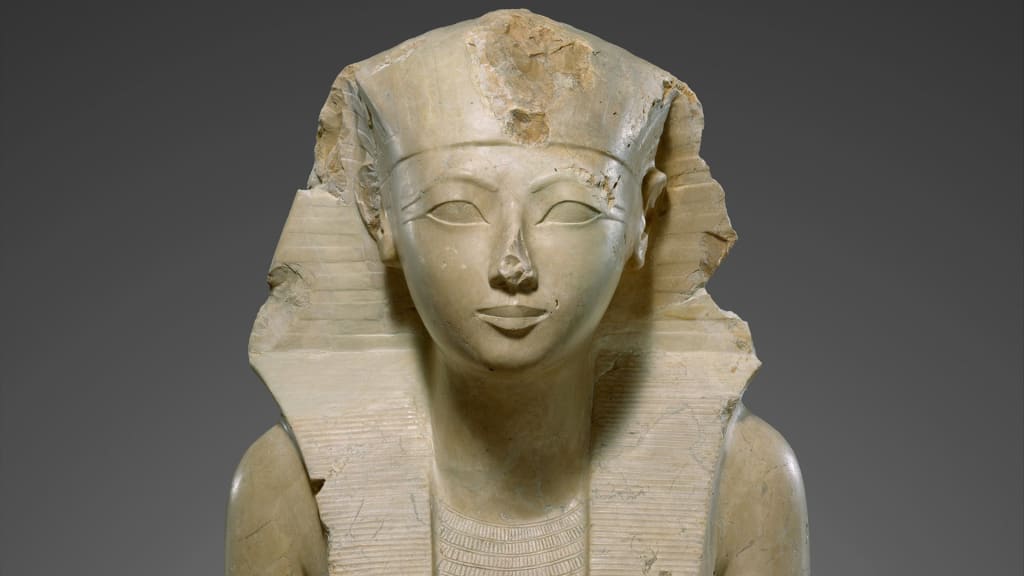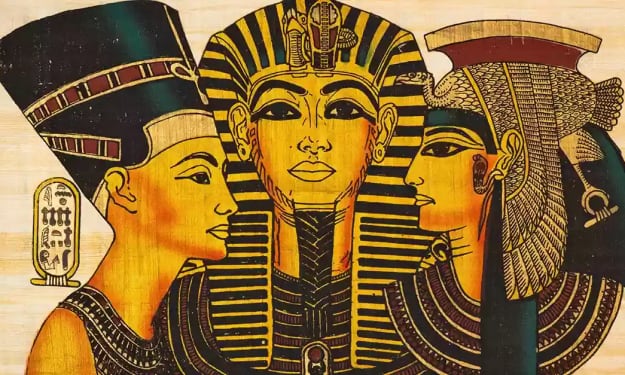Hatshepsut: The Queen Who Ruled Egypt and Rocked a Crown
8 interesting facts on her life and legacy

Introduction
In the vast annals of ancient Egyptian history, one name stands out as a testament to female power and greatness: Hatshepsut. Often referred to as the "Queen Who Ruled Egypt and Rocked a Crown," Hatshepsut defied societal norms and ascended to the throne as the first female pharaoh. Her reign, which lasted for over two decades, remains a fascinating and controversial chapter in the history of ancient Egypt.
#1 The Rise to Power of Hatshepsut
Hatshepsut was born into the powerful 18th Dynasty of Egypt, a time of great political and cultural significance. She was the daughter of Pharaoh Thutmose I and Queen Ahmose, and her upbringing within the royal family exposed her to the intricacies of governance from an early age. However, it was not until the unexpected death of her half-brother and husband, Thutmose II, that Hatshepsut's path to the throne was paved.
As the designated regent for her young stepson, Thutmose III, Hatshepsut seized the opportunity to assume a more prominent role in Egyptian politics. In a bold move, she declared herself pharaoh, donning the traditional regalia of kingship, including the iconic double crown of Upper and Lower Egypt. Hatshepsut's audacity and political acumen astounded her contemporaries and set the stage for her extraordinary reign.
#2 Hatshepsut's Achievements as a Ruler
Hatshepsut's reign as pharaoh was characterised by an unprecedented focus on trade, diplomacy, and monumental building projects. She sought to strengthen Egypt's economic power and secure its influence in the region. Under her rule, Egypt experienced a period of prosperity and stability.
One of Hatshepsut's most notable achievements was her expedition to the ancient land of Punt, a region rich in resources such as gold, incense, and exotic animals. This successful venture not only bolstered Egypt's wealth but also established diplomatic ties with Punt, further solidifying Hatshepsut's reputation as a shrewd and capable leader.
Additionally, Hatshepsut left an indelible mark on the architectural landscape of Egypt. Her mortuary temple at Deir el-Bahari, located on the west bank of the Nile near Thebes, is a masterpiece of ancient Egyptian architecture. Its grandeur and innovative design serve as a testament to Hatshepsut's vision and artistic sensibilities.
#3 The Controversy Surrounding Hatshepsut's Reign
Despite her many accomplishments, Hatshepsut's reign was not without controversy. As a woman in a male-dominated society, she faced resistance and scrutiny from both the ruling elite and later historians. After her death, attempts were made to erase her legacy, and her statues and inscriptions were defaced or destroyed.
The reasons behind this deliberate erasure of Hatshepsut's reign remain unclear, but theories abound. Some suggest that subsequent pharaohs sought to strengthen their own claims to the throne by eradicating any evidence of a female ruler. Others argue that Hatshepsut's unprecedented power threatened established norms and challenged traditional gender roles, leading to a campaign to diminish her significance.
#4 The Artistic and Architectural Legacy of Hatshepsut
Despite the attempts to erase her from history, remnants of Hatshepsut's artistic and architectural legacy endure to this day. Her mortuary temple at Deir el-Bahari, with its imposing colonnades and intricate reliefs, showcases the grandeur and sophistication of her reign. The temple's unique design, blending seamlessly into the surrounding cliffs, is a testament to the architectural ingenuity of ancient Egypt.
Hatshepsut's statues, though defaced, still exude a sense of regal authority and femininity. Her depiction with a false beard and traditional male attire is a striking symbol of her claim to the throne and her defiance of gender norms. These artistic representations serve as a lasting testament to her power and influence.
#5 Hatshepsut's Impact on Women in Ancient Egypt
Hatshepsut's unprecedented rise to power and successful reign had a profound impact on the role of women in ancient Egypt. While women had held positions of authority before her, none had achieved the level of power and autonomy that she did. Hatshepsut shattered the glass ceiling of ancient Egyptian society, inspiring future generations of women to challenge societal norms and pursue positions of leadership.
Her reign also provided a blueprint for female rulers to follow. Despite the subsequent attempts to erase her legacy, Hatshepsut remains an icon of female empowerment and a symbol of what women can achieve when given the opportunity.
#6 The Death and Legacy of Hatshepsut
Hatshepsut's reign came to an end after approximately twenty-two years on the throne. The circumstances surrounding her death remain shrouded in mystery, with some suggesting that she succumbed to a natural illness, while others propose foul play. Regardless of the cause, Hatshepsut's legacy continued to resonate long after her passing.
Her successor, Thutmose III, initially sought to erase all traces of Hatshepsut's reign, but ultimately her achievements proved too significant to ignore. Thutmose III acknowledged her contributions and even had her statues restored, ensuring that her memory would endure.
#7 The Discovery and Excavation of Hatshepsut's Temple
Hatshepsut's mortuary temple at Deir el-Bahari lay hidden beneath the sands of Egypt for centuries. It wasn't until the early nineteenth century that the temple was rediscovered and brought to the world's attention. Excavations revealed the grandeur and magnificence of Hatshepsut's architectural masterpiece, rekindling interest in her reign and reigniting debates about her legacy.
The temple's excavation and ongoing restoration work continue to provide valuable insights into ancient Egyptian culture, art, and architecture. It serves as a tangible reminder of Hatshepsut's enduring impact on the world.
#8 The Portrayal of Hatshepsut in Popular Culture
Hatshepsut's fascinating story has captured the imagination of artists, writers, and filmmakers throughout history. Her unique position as a female ruler in ancient Egypt has inspired countless works of art, literature, and film.
From historical novels that bring her reign to life to blockbuster movies that reimagine her story, Hatshepsut continues to captivate audiences worldwide. Her portrayal in popular culture serves as a testament to the enduring fascination with this remarkable woman and the legacy she left behind.
Conclusion
Hatshepsut, the Queen Who Ruled Egypt and Rocked a Crown, remains an enigmatic figure in the annals of ancient history. Her rise to power, achievements as a ruler, and enduring legacy continue to inspire and captivate. Despite the controversy surrounding her reign and subsequent attempts to erase her from history, Hatshepsut's impact on ancient Egypt and women in positions of power cannot be denied. Her story serves as a reminder that greatness knows no gender and that true leadership transcends societal expectations. Hatshepsut's legacy serves as an enduring testament to the power of ambition, perseverance, and the indomitable human spirit.
Join us on a journey through ancient Egypt as we explore the life and legacy of Hatshepsut, the Queen Who Ruled Egypt and Rocked a Crown. Discover the wonders of her reign and the enduring impact she had on women in positions of power. Embrace the spirit of female empowerment and learn from the remarkable achievements of this legendary queen.
About the Creator
Enjoyed the story? Support the Creator.
Subscribe for free to receive all their stories in your feed. You could also pledge your support or give them a one-off tip, letting them know you appreciate their work.





Comments
Lane Montgomery is not accepting comments at the moment
Want to show your support? Send them a one-off tip.